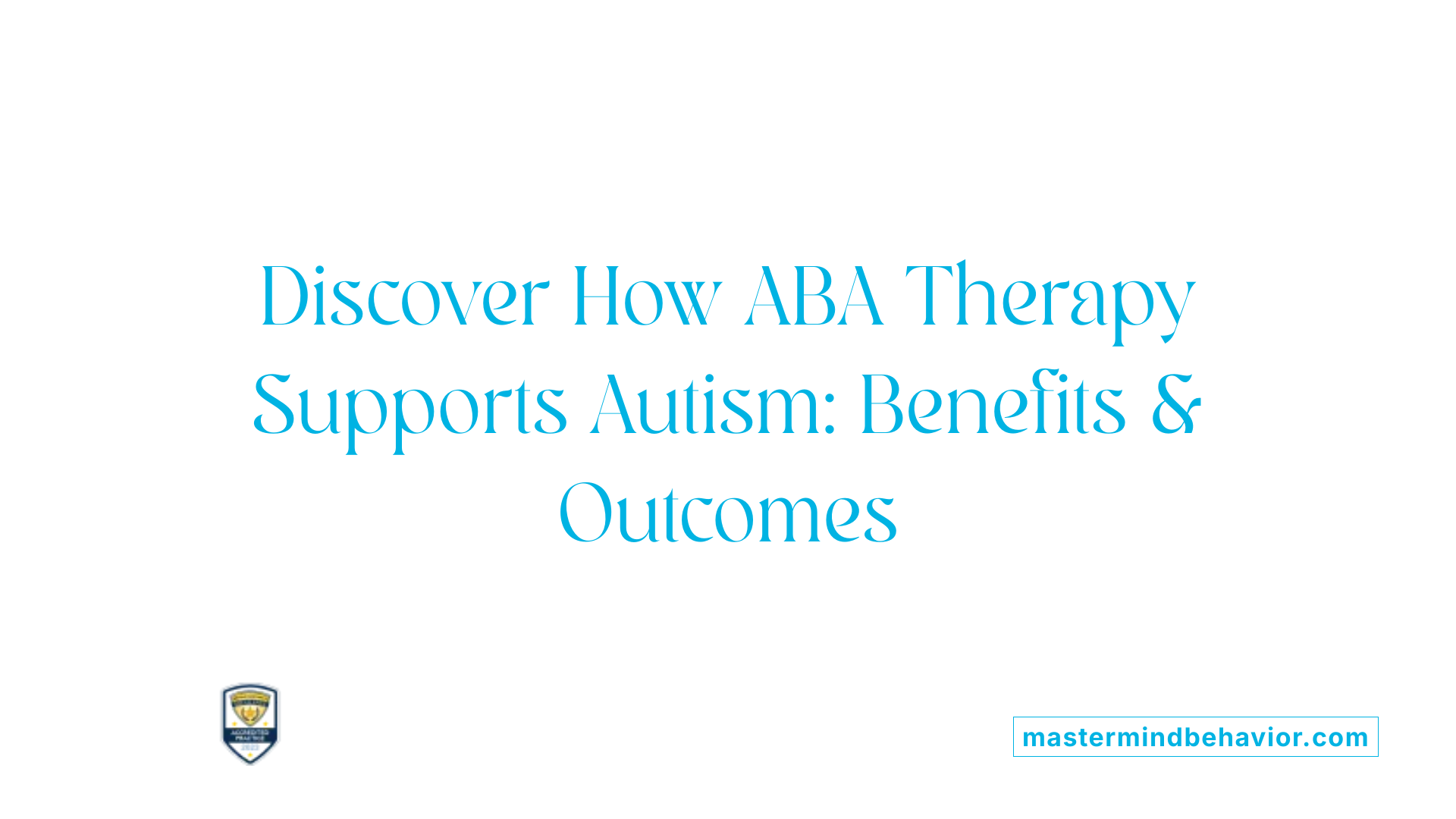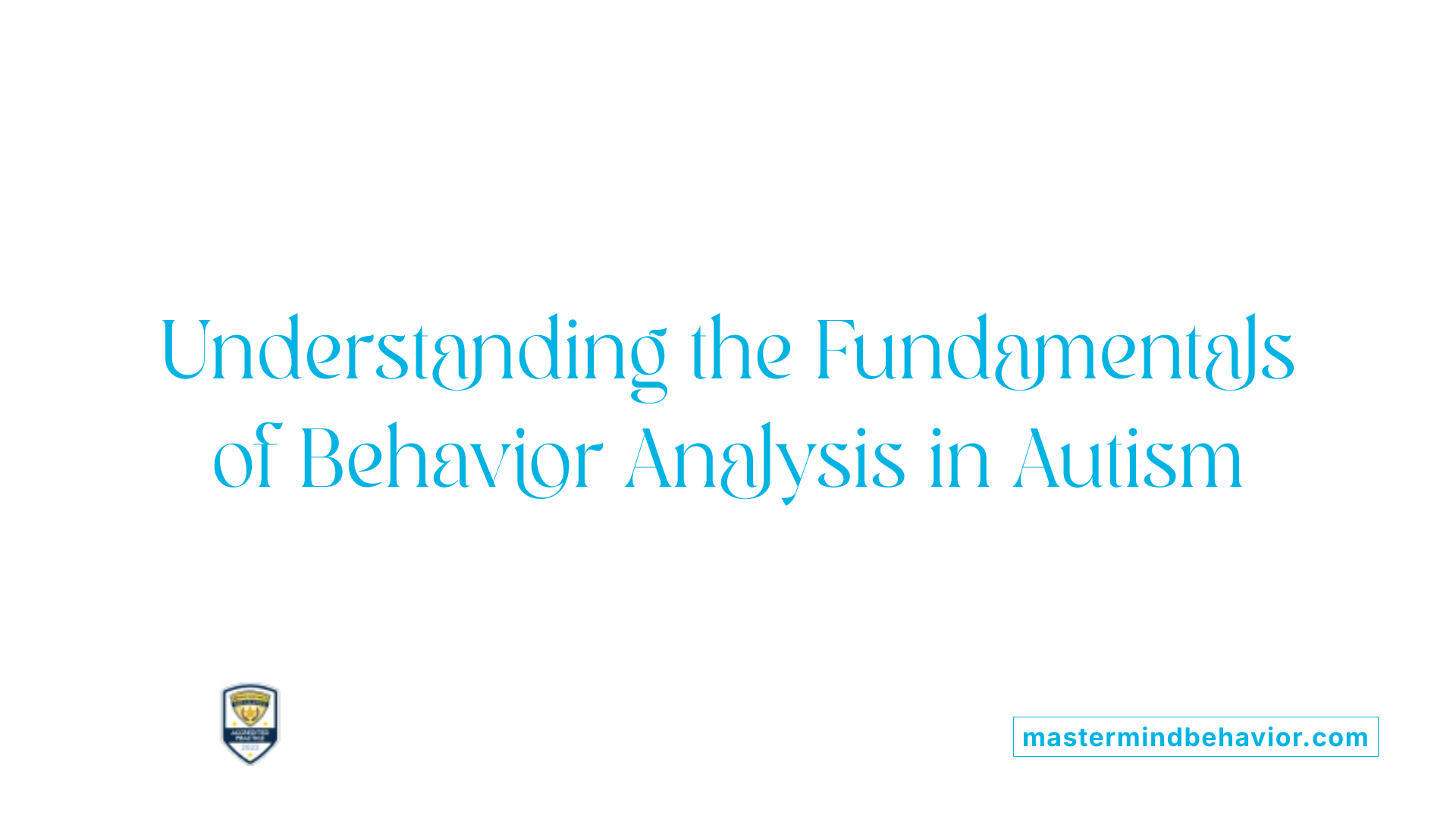Teaching Planning And Sequencing Using ABA Therapy

Understanding ABA Therapy in Autism and Behavioral Intervention
Applied Behavior Analysis (ABA) therapy is a scientifically supported intervention focused on modifying behavior by understanding its function and utilizing evidence-based strategies. It is extensively used in autism therapy but also benefits individuals with diverse developmental challenges. This article explores how ABA techniques facilitate teaching planning and sequencing skills, emphasizing the therapy’s core principles, implementation strategies, and benefits.
What Is ABA Therapy and Its Benefits for Autism?

Definition of ABA therapy
Applied Behavior Analysis (ABA) therapy is a science-based approach that studies behavior and how it can be modified through environmental factors. It focuses on encouraging positive behaviors like communication and daily living skills while decreasing harmful or disruptive behaviors. ABA techniques include positive reinforcement, prompting, shaping, and chaining and rely on careful observation and data collection to adapt strategies.
Benefits for individuals with autism
ABA is widely recognized as an effective treatment to help children with autism spectrum disorder (ASD) improve communication, social skills, and adaptive behavior. It fosters independence and reduces challenging behaviors by teaching new skills through clear, systematic methods. Many studies show early ABA intervention enhances language development and social engagement.
Flexibility and evidence-based approach
ABA therapy uses evidence-based, individualized methods adapted for each child’s unique needs. Techniques such as Discrete Trial Training, Pivotal Response Treatment, and naturalistic teaching ensure flexibility across various learning environments. Professionals regularly analyze data to adjust interventions and maximize progress.
Personalized treatment plans
Trained clinicians develop personalized treatment plans based on thorough assessments including standardized tools and direct observations. These plans focus on pivotal behaviors like motivation, imitation, communication, and self-regulation, broken down into manageable steps rewarded through consistent reinforcement.
Early intervention significance
Starting ABA therapy early, typically between ages 2 to 5, leads to the most substantial improvements in language, socialization, and behavior. Early intervention lays a strong foundation for school readiness, enhancing long-term developmental outcomes and quality of life for children with autism.
Core Principles of Behavioral Analysis in Autism Therapy

What are the core principles behind behavioral analysis used in autism therapy?
Behavioral analysis in autism therapy is founded on the science of learning and behavior, focusing on changing behavior in positive ways. This is chiefly done through reinforcement — rewarding helpful behaviors to encourage them and reducing harmful behaviors.
The approach uses several teaching techniques:
- Shaping: Gradually molding a new behavior by reinforcing closer approximations.
- Chaining: Breaking down complex skills into small steps taught one at a time and linked together.
- Prompting: Providing cues or assistance to initiate a behavior, then fading prompts as the learner gains independence.
ABA also uses the ABC model which stands for Antecedent, Behavior, and Consequence. This helps identify what triggers a behavior (antecedent), what the behavior is, and what follows it (consequence). Understanding this sequence supports behavior modification.
A critical tool is the Functional Behavior Assessment (FBA), which investigates the purpose or function behind a behavior—whether to gain attention, avoid tasks, or meet sensory needs. This guides the creation of tailored interventions.
Data collection and treatment adjustment
ABA therapy relies heavily on systematic data collection. Behavior Analysts track frequency, duration, and accuracy of behaviors to monitor progress. This data informs ongoing adjustments to intervention strategies, ensuring the plan remains effective and individualized.
Overall, applied behavior analysis emphasizes evidence-based techniques, positive reinforcement, and continuous monitoring, supporting children with autism to develop communication, social, and adaptive skills in various environments.
Professional Providers of ABA Therapy and Their Qualifications

Who Typically Provides ABA Therapy, and What Qualifications Do These Professionals Have?
ABA therapy is delivered by a range of qualified professionals committed to supporting individuals' behavioral and developmental progress. The principal providers include Board-Certified Behavior Analysts (BCBAs), Licensed Behavior Analysts (LBAs), Certified Behavior Analyst Assistants (CBAAs), and Registered Behavior Technicians (RBTs).
BCBAs and LBAs possess advanced degrees, generally at the master's or doctoral level, in Applied Behavior Analysis or related disciplines. Their credentials require rigorous coursework, supervised practical experience, and passing certification exams. These qualifications equip them to design, oversee, and adjust individualized ABA treatment plans tailored to clients' unique needs.
CBAAs and RBTs support the therapy process by implementing intervention strategies under the close supervision of a BCBA or LBA. CBAAs often assist in assessments and help develop behavior plans, while RBTs focus primarily on direct intervention delivery, adhering strictly to established protocols.
Supervision is critical; all ABA providers must work within a licensed or certified framework. This framework mandates continuous oversight, ongoing education, and adherence to ethical and professional standards. Regulatory standards vary by region but universally emphasize the importance of certified professionals leading therapy to ensure effective, evidence-based practice.
Collaboration is also essential in ABA service delivery. Therapy teams may include BCBAs, LBAs, CBAAs, RBTs, and other allied health professionals. Effective teamwork enhances communication, fosters consistent intervention implementation, and promotes positive outcomes for clients.
| Provider Type | Qualifications | Role and Responsibilities |
|---|---|---|
| Board-Certified Behavior Analyst (BCBA) | Master's/doctoral degree, certification exam, supervised experience | Designs and supervises ABA programs, conducts assessments, adjusts interventions |
| Licensed Behavior Analyst (LBA) | State licensure, similar educational and experiential requirements as BCBA | Provides ABA therapy independently as authorized by state regulations |
| Certified Behavior Analyst Assistant (CBAA) | Specific assistant-level certification, supervised experience | Assists with assessments, supports BCBA/LBA in program implementation |
| Registered Behavior Technician (RBT) | Certification via coursework and competency assessment | Implements ABA interventions directly under supervision |
Understanding each provider's qualifications and roles clarifies the structure of ABA therapy services. It ensures that therapy is delivered effectively, ethically, and according to best practices, ultimately contributing to meaningful and measurable improvements in individuals' lives.
Teaching Planning and Sequencing Through ABA Techniques

Breaking down complex tasks into small steps
ABA therapy emphasizes dividing complicated tasks into manageable, smaller steps, which helps reduce overwhelm for children and supports steady progress. This breakdown is essential in enabling learners to focus on one component at a time, simplifying skill acquisition and enhancing understanding.
Task analysis for skill development
Task analysis is a core ABA strategy that involves systematically identifying and teaching each discrete action within a larger skill. By teaching each element separately, educators can effectively build competence while monitoring progress closely, making adjustments when necessary.
Use of prompting and fading
Teachers use prompting to guide learners through each step, providing cues or assistance when needed. Gradually, prompts are faded to encourage independence, ensuring that children can carry out the tasks without assistance over time.
Shaping and chaining to teach sequences
Shaping involves reinforcing successive approximations of a behavior to gradually reach the target skill. Chaining builds sequences by teaching individual steps in order, either forward or backward, linking them to develop complex behaviors like preparing for school or self-care routines.
Visual supports to aid understanding
Visual aids—such as step-by-step activity visuals, turn-taking cues, and First/Then boards—help children better understand expectations and sequence flows. These supports are especially beneficial for learners with autism, improving compliance and engagement.
Reinforcing completion of each step
Positive reinforcement is delivered immediately after successful completion of each step, using praise or preferred items. This strengthens motivation and builds positive associations with task completion, encouraging consistent effort.
Encouraging independence and follow-through
By combining stepwise teaching, visual supports, and fading of prompts, ABA techniques foster greater independence. Students learn to follow through on activities independently, developing essential coping skills for less-preferred or complex tasks over time.
ABA Strategies for Classroom Management and Skill Acquisition
How do ABA classroom strategies improve behavior and learning?
ABA strategies in the classroom focus on understanding the purpose of behavior, modifying the environment, and applying consistent reinforcement and consequences. These approaches create less stressful and more structured settings, helping students develop communication, social, and learning skills more effectively.
What role does positive reinforcement and token economies play?
Positive reinforcement is crucial in ABA classroom management. Strategies like token economies reward good behavior and learning milestones, motivating students to engage and develop social skills. Immediate rewards such as praise or preferred items reinforce desired behaviors and aid skill acquisition.
How are structured work sessions and play activities integrated?
ABA incorporates both structured teaching sessions and various play types—functional, pretend, interactive, parallel, and cooperative—to promote development. Using visual supports and breaking down tasks into manageable steps helps children follow play plans and complete activities, bolstering engagement and learning.
What are five key ABA teaching methods used?
The widely used ABA teaching strategies include:
| Method | Description | Application in Classroom |
|---|---|---|
| Discrete Trial Teaching | Intensive, structured teaching with clear goals and prompts | Skill development with immediate reinforcement |
| Naturalistic Teaching | Learning in natural environments with child's interests | Encourages spontaneous communication and social skills |
| Pivotal Response Treatment | Focuses on pivotal areas like motivation and self-management | Improves broader behavioral and learning outcomes |
| Token Economy | Rewards tokens exchanged for preferred items | Promotes continued motivation and positive behavior |
| Contingent Observation | Observing behavior with specific consequences | Helps reduce undesirable behaviors through natural consequences |
Why are consistent behavior plans important?
Consistency in applying ABA behavior plans ensures steady progress. Regular data collection and program monitoring allow adjustments to individual needs. This consistency leads to notable improvements in behavior, skill mastery, and classroom participation.
How does ABA improve communication, social, and learning outcomes in classrooms?
ABA targets pivotal skills such as imitation, joint attention, and self-regulation. Early intensive intervention helps children improve language and social engagement, laying a foundation for academic success. Collaboration between teachers, therapists, and families further enhances these outcomes.
The Role of Early Intervention and Family Involvement in ABA Therapy

How does early ABA intervention impact children between ages 2-5?
Early intervention with Applied Behavior Analysis (ABA) therapy during the critical developmental window of ages 2 to 5 significantly improves outcomes for children, especially those diagnosed with Autism Spectrum Disorder (ASD). During this period, ABA can enhance language acquisition, social engagement, and adaptive behaviors, setting a strong foundation for future learning and development.
What improvements are observed in language, social, and adaptive skills?
Research shows that children receiving early ABA therapy make notable gains in communication abilities, such as understanding and using language, which facilitates better social interactions. Similarly, targeted ABA plans promote adaptive skills, including self-care and daily living routines, enabling children to function more independently.
How does ABA reduce challenging behaviors?
ABA interventions aim to decrease challenging or harmful behaviors by teaching replacement skills and reinforcing positive actions. Consistent application of individualized behavior plans during these formative years helps children develop self-regulation and coping strategies, minimizing disruptive tendencies.
Why is parental involvement crucial in ABA therapy?
Active parental participation is essential in maximizing ABA's effectiveness. Parents collaborate in setting realistic, individualized goals and deploying reinforcement strategies at home, which bolsters the consistency and generalization of learned skills.
How is continuity maintained between therapy sessions and home settings?
Maintaining continuity requires consistent communication and collaboration between therapists, teachers, and families. When parents reinforce therapy goals and use ABA strategies in everyday situations, children receive coherent messages and practice opportunities, accelerating their progress.
What role does collaboration among therapists, teachers, and families play?
A collaborative approach ensures all adults involved share data, adapt strategies, and monitor progress to meet the child's evolving needs. This united support network fosters a less stressful learning environment and stronger relationships, enhancing overall developmental outcomes.
Data-Driven Individualized ABA Programs for Skill Development
What Assessment Tools Are Used by BCBAs to Guide ABA Programs?
Board Certified Behavior Analysts (BCBAs) use a variety of standardized assessment tools to gain a comprehensive understanding of each child's abilities and needs. Common tools include the VB-MAPP (Verbal Behavior Milestones Assessment and Placement Program), Vineland Adaptive Behavior Scales, ABLLS-R (Assessment of Basic Language and Learning Skills-Revised), PEAK (Promoting the Emergence of Advanced Knowledge), and AFLS (Assessment of Functional Living Skills). These instruments, combined with indirect assessments like caregiver interviews and direct observations, provide data critical to designing personalized ABA programs.
How Are Individualized Goals Created Based on These Assessments?
After thorough assessments, BCBAs set individualized goals that target specific skill areas. These goals focus not only on general skill acquisition but also on pivotal behaviors—such as motivation, imitation, and initiation—and behavioral cusps including communication, play, and daily living skills. The aim is to foster functional independence and promote generalized learning across settings.
What Techniques Are Used to Monitor Progress?
ABA programs rely on systematic data collection methods tailored to each child's needs. This includes tracking frequency and duration of behaviors and recording correct or incorrect responses to interventions. Data collection allows for continuous monitoring of progress, guiding necessary adjustments to teaching strategies.
How Is Program Effectiveness Maintained Through Ongoing Monitoring?
Regular program monitoring involves analyzing collected data to ensure interventions maintain fidelity and effectiveness. BCBAs and therapy teams review progress frequently, making data-driven decisions to modify behavior plans or teaching methods as needed to optimize outcomes.
Why Is a Collaborative Therapy Team Approach Important?
Successful ABA implementation depends on collaboration among various team members—including BCBAs, therapists, educators, and family caregivers. Coordinated efforts ensure consistent application of strategies across different environments, reinforcing learning and behavior changes for the child.
| Aspect | Description | Purpose |
|---|---|---|
| Assessment Tools | VB-MAPP, Vineland, ABLLS-R, PEAK, AFLS, caregiver interviews, direct observation | Identify strengths, needs, and skill levels |
| Individualized Goals | Focus on pivotal behaviors and behavioral cusps | Target functional, meaningful skill gains |
| Data Collection Methods | Frequency, duration, correct/incorrect response tracking | Monitor real-time progress and effectiveness |
| Ongoing Monitoring | Regular data analysis and program adjustments | Maintain intervention fidelity and success |
| Collaborative Approach | Engagement of BCBAs, therapists, educators, families | Ensure consistency and generalization |
The Impact and Future of Planning and Sequencing Education with ABA Therapy
Teaching planning and sequencing through ABA therapy offers a structured, scientifically grounded pathway to improving independence and life skills for individuals with autism and related disorders. By harnessing ABA’s core principles—breaking tasks into manageable steps, using reinforcement, and tailoring interventions to individual needs—therapists and educators can foster greater learning, reduce challenging behaviors, and facilitate smoother transitions. Early intervention combined with collaborative support from professionals and families ensures ABA’s maximum benefit. As research and practice continue evolving, ABA remains an essential, adaptable framework to empower individuals in mastering essential skills for daily living and social integration.
References
- How to Use ABA in the Classroom
- Maximizing Progress with Applied Behavioral Analysis (ABA)
- Play Plans in Applied Behavior Analysis (ABA)
- Applied Behavior Analysis (ABA) for Children With Autism
- Creating a Meaningful Skill Acquisition Program ... - Master ABA
- Guidance on the Roles of Licensed Providers and Unlicensed ...
- How to Become an ABA Therapist - School of Education
Recent articles

Teaching Planning And Organization With ABA Tools
Enhancing Independence Through Structured ABA Strategies

Teaching Planning And Sequencing Using ABA Therapy
Enhancing Learning and Life Skills Through ABA-Based Planning and Sequencing

How ABA Therapy Encourages Healthy Risk Assessment Skills
Enhancing Decision-Making and Safety Awareness Through ABA Therapy

How ABA Therapy Improves Classroom Group Participation
Enhancing Classroom Dynamics Through Applied Behavior Analysis

ABA Therapy To Reduce Disruptions During Group Activities
Enhancing Group Participation: The Role of ABA Therapy in Managing Behavioral Disruptions

How ABA Therapy Encourages Safe Risk Taking In Community Settings
Empowering Autistic Individuals Through Structured Community Engagement



